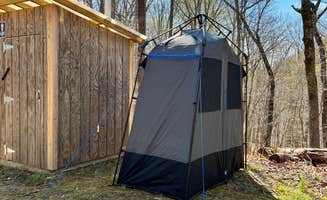Dispersed camping near Chester, Illinois offers opportunities in the Shawnee National Forest region. Sites vary from basic car-accessible locations to remote wilderness areas requiring hikes to reach. Winter temperatures in this region typically range from 20°F to 40°F, with summer highs often exceeding 90°F. Most dispersed camping locations remain accessible year-round, though forest roads can become challenging after heavy rainfall.
What to do
Seasonal hiking exploration: Trail of Tears State Forest provides multiple hiking trails through hardwood forests with particularly vibrant foliage during autumn months. The forest contains over 5 miles of marked trails ranging from easy to moderate difficulty. A visitor noted, "Surprised to find nice porta potty at our site that was remote from others. Potable water and camper registration (but had a boil water warning but that was not normal)."
Wildlife observation: Panther Den Wilderness, Shawnee National Forest features unique sandstone formations and diverse wildlife habitat. The wilderness area spans approximately 685 acres with no maintained trails, requiring navigation skills. Winter and early spring offer the best visibility through the forest understory.
Rock formation exploration: The distinctive sandstone bluffs throughout the region provide opportunities for geological exploration. Several formations contain small caves and rock shelters used by indigenous peoples. Morning hours typically offer the best lighting conditions for photography of these formations.
What campers like
Quiet camping locations: Trail of Tears State Forest offers dispersed sites set apart from each other, creating natural privacy barriers. The forest charges $8 per night for camping, which campers find reasonable for the experience. One camper shared, "Remote and rugged" while another mentioned being "remote from others."
Natural water features: Several camping areas contain seasonal creeks and small waterfalls, particularly after spring rains. These water features attract diverse wildlife and provide pleasant ambient sounds for nearby campsites. Water levels typically peak in March and April.
Dark sky viewing: Limited light pollution in the forest areas creates excellent conditions for stargazing and night photography. Clear nights reveal the Milky Way during summer months, with peak viewing between June and September. Campers recommend bringing red-light headlamps to preserve night vision.
What you should know
Road access considerations: During wet conditions, access roads to many dispersed sites require vehicles with higher clearance. Some forest roads remain unpaved and develop significant ruts after rainfall. Winter conditions rarely include snow but can feature icy patches on north-facing slopes.
Water availability: Most dispersed camping areas require carrying in all drinking water, with few reliable natural sources. When water is available at designated areas, temporary boil advisories may be in effect. A camper at Trail of Tears noted, "Potable water and camper registration (but had a boil water warning but that was not normal)."
Cell service limitations: Cellular coverage throughout the camping areas ranges from spotty to nonexistent. Sites closer to main highways typically have better service than those deeper in the forest. Verizon generally provides the most consistent coverage in the region.
Tips for camping with families
Beginner-friendly sites: Some dispersed camping areas offer more amenities than others, making them better suited for families. Bill C. mentioned Trail of Tears has a "Nice picnic table and raised fire ring/grill," which simplifies meal preparation with children. Sites closer to the forest entrance typically provide easier access to these amenities.
Wildlife education opportunities: Trail of Tears State Forest contains interpretive signage identifying local tree species and habitat types. These educational resources create natural learning opportunities for children while exploring the forest. Spring and early summer offer the best wildflower viewing opportunities.
Safety considerations: While relatively safe, the forest areas contain typical Midwestern hazards including poison ivy, ticks, and occasional venomous snakes. Camping areas with more open ground typically have fewer ticks than heavily wooded sites. Parents should conduct daily tick checks, particularly during warm months.
Tips from RVers
Site accessibility: Larger dispersed camping areas in Trail of Tears can accommodate modest-sized RVs and trailers, though turning space may be limited. Sites nearest the forest entrance provide the most reliable access for larger vehicles. One camper noted, "30 min into Cape Girardeau and 15 min to Anna," making supply runs relatively convenient.
Hookup considerations: No electric, water, or sewer hookups exist at dispersed camping locations near Chester. RVers must be fully self-contained with sufficient battery power and water storage. Solar panels function best in sites with partial clearings that receive southern exposure.
Leveling challenges: Many sites feature uneven terrain requiring significant leveling equipment for RVs. Bringing extra leveling blocks is recommended as many sites have slopes exceeding 5 degrees. Sites along ridge lines typically provide more level camping surfaces than those in valleys.


